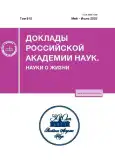THE LIFETIME OF COLOUR MORPHS IN THE POLYMORPHIC POPULATIONS OF THE MOLE VOLE AND THE HYPOTHESIS OF ADAPTIVE POLYMORPHISM
- Авторлар: Vasil’ev A.G.1, Bol’shakov V.N.1, Vasil’eva I.A.1, Sineva N.V.1
-
Мекемелер:
- Federal State Budgetary Institution of Science Institute of Plant and Animal Ecology of the Ural Branch of the Russian Academy of Sciences
- Шығарылым: Том 510, № 1 (2023)
- Беттер: 283-287
- Бөлім: Articles
- URL: https://journals.rcsi.science/2686-7389/article/view/135698
- DOI: https://doi.org/10.31857/S2686738922601035
- EDN: https://elibrary.ru/QFVBRE
- ID: 135698
Дәйексөз келтіру
Толық мәтін
Аннотация
For the first time, different lifetime was established in representatives of three colour morphs (brown, bicolor, black) in 10 populations of the Mole Vole of the Volga region, the Urals and the Trans-Urals. With the longest life span of the species – 5 years, numerically dominant morphs in the population are able to live 1–4 years longer than the accompanying ones. Spearman’s correlation coefficient between the longest life span of morphs and their proportion in the population was Rsp = 0.81. A number of morphofunctional features of colour morphs have been identified. The results obtained have general biological significance, confirming the hypothesis of adaptive polymorphism, and allowing us to evaluate the evolutionary and ecological mechanisms of the formation of selective advantages of morphs (as probable ecomorphs), using them as a natural model of the initial stage of sympatric formation in different parts of the range.
Негізгі сөздер
Авторлар туралы
A. Vasil’ev
Federal State Budgetary Institution of Science Institute of Plant and Animal Ecology of the Ural Branchof the Russian Academy of Sciences
Хат алмасуға жауапты Автор.
Email: vag@ipae.uran.ru
Russian Federation, Yekaterinburg
V. Bol’shakov
Federal State Budgetary Institution of Science Institute of Plant and Animal Ecology of the Ural Branchof the Russian Academy of Sciences
Email: vag@ipae.uran.ru
Russian Federation, Yekaterinburg
I. Vasil’eva
Federal State Budgetary Institution of Science Institute of Plant and Animal Ecology of the Ural Branchof the Russian Academy of Sciences
Email: vag@ipae.uran.ru
Russian Federation, Yekaterinburg
N. Sineva
Federal State Budgetary Institution of Science Institute of Plant and Animal Ecology of the Ural Branchof the Russian Academy of Sciences
Email: vag@ipae.uran.ru
Russian Federation, Yekaterinburg
Әдебиет тізімі
- Timofeev-Ressovsky N.W. Zur Analyse des Polymorphismus bei Adalia bipunctata // Biol. Zbl. 1940. Bd. 60. (3/4). S. 130.
- Тимофеев-Ресовский Н.В., Свирежев Ю.М. Об адаптационном полиморфизме в популяциях Adalia bipunctata // Проблемы кибернетики, 1965. Т. 16. С. 137–146.
- Gershenson S.M. Evolutionary studies on the distribution and dynamics of melanism in the hamsters (Cricetus cricetus). I., II // Genetics. 1945. V. 30. P. 207–252.
- Kettlewell H.B.D. Selection experiments on industrial melanism in the Lepidoptera /// Heredity. 1955. V. 9. P. 323–342.
- Шеппард Ф.М. Естественный отбор и наследственность. М.: “Просвещение”, 1970.
- Cain A.J. The scoring of polymorphic colour and pattern variation and its genetic basis in moluscan shells // Malacologia. 1988. V. 28. (1–2). P. 1–15.
- Salzburger W. Understanding explosive diversification through cichlid fish genomics // Nature Reviews Genetics. 2018. V. 19. (11). P. 705–717.
- Coelho P., Kaliontzopoulou A., Sousa P., et al. Reevaluating scorpion ecomorphs using a naïve approach // BMC Ecology and Evolution. 2022. V. 22. № 17. P. 1–10.
- Евдокимов Н.Г. Популяционная экология обыкновенной слепушонки. Екатеринбург: Изд-во “Екатеринбург”, 2001.
- Кропачева Ю.Э., Чепраков М.И., Синева Н.В., и др. Размеры тела и зубов обыкновенной слепушонки (Ellobius talpinus, Rodentia, Cricetidae) в зависимости от возраста и условий обитания // Зоол. журнал. 2017. Т. 96. № 11. С. 1419–1424.
- Евдокимов Н.Г., Синева Н.В., Васильев А.Г. Многолетний тренд увеличения доли меланистов в Курганской популяции обыкновенной слепушонки (Ellobius talpinus) на фоне изменения климата Зауралья // Экология. 2017. № 4. С. 312–314.
- Чепраков М.И., Евдокимов Н.Г., Глотов Н.В. Наследование окраски меха у обыкновенной слепушонки (Ellobius talpinus Pall.) // Генетика. 2005. Т. 41. № 11. С. 1552–1558.
- Васильев А.Г., Большаков В.Н., Евдокимов Н.Г., et al. Морфоразнообразие моно‑ и полиморфных популяций обыкновенной слепушонки: реализуется ли “принцип компенсации” Ю.И. Чернова внутри популяции? // Доклады Академии наук. 2016. Т. 468. № 1. С. 118–121.
Қосымша файлдар









